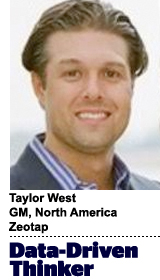 “Data-Driven Thinking” is written by members of the media community and contains fresh ideas on the digital revolution in media.
“Data-Driven Thinking” is written by members of the media community and contains fresh ideas on the digital revolution in media.
Today’s column is written by Taylor West, general manager, North America, at Zeotap.
“Trust, but verify” was a phrase made famous by President Ronald Reagan during the Cold War in reference to Soviet disarmament, and it makes sense in many other contexts today, including the collection of user data.
Let’s face it: The quality of mobile data is poor because of the industry’s dependence on incomplete or inaccurate data collection. There are a couple of different methods commonly used today, but there is a clear need for greater verification and auditing in EMEA, APAC and the United States.
Probabilistic or inferred data are essentially assumptions made about users based on online activities and behavior, such as user location history. Although inferred data relies heavily on machine learning, it is still an educated guess or a probable scenario.
Large CPG companies like P&G and Unilever only feel comfortable buying when demographic data, such as combined age and gender, reaches certain thresholds, say 70% on-target reach. While predicting gender is quite simple, predicting age brackets probabilistically is much more difficult.
Self-reported or declared data is gained when individuals fill out personal information, such as on a social media site, which can be slightly more accurate but still relies on the honesty of the user. If you consider the distortions of truth on, say, a dating app like Bumble or Tinder, there’s a lot of room for error.
Verified mobile data has been checked for inaccuracies by the data owner. Telcos can provide verified socio-economic information because a photo ID is required when customers create mobile accounts, and telco data is also tied to mobile ad IDs.
Historically, these companies have been reluctant to release their data for obvious security and privacy reasons, but more have gotten on board during the past year or so. With almost universal adoption of mobile phones, there is less growth in acquiring new users; therefore, new revenue streams will have to come from monetizing valuable data.
This could be a game-changer for the quality of mobile data around the globe, yet challenges still exist, particularly in the US.
Unique Challenges In The United States
Unfortunately, first-party telco data in the United States isn’t as clear-cut as in other parts of the world because of the prevalence of family plans, which skew individual user data. For US advertisers, the ideal scenario would be to work with other large companies, such as banks or payroll providers, but many of these companies are also hesitant to monetize it.
For now, US advertisers will need to continue using inferred and declared data, until they can find partners willing to offer verified first-party data.
Industry Rating Standards And Independent Auditor
Ultimately, there is a clear need for an authoritative entity to set industry standards and act as an auditor – similar to MRC accreditation – by testing and scoring demographic data for greater accuracy. This should take place not only post-campaign but ideally pre-campaign, or advertisers are left guessing what their performance will be until after campaigns have run. Such a move could certainly help bring the US closer to par with EMEA and other global markets, and soon everyone might be speaking the same language.
Partnerships like the one recently announced by the ARF and the Coalition for Innovative Media Measurement that proposes a data labeling program for basic information on when data is collected, how fresh it is, the data source, the collection method and type of modeling used demonstrate that influential industry bodies are wisely searching for smart solutions. Labeling is just a first step, but a very important one.
There are any number of capable industry organizations, or possibly even external firms, that could help everyone navigate the mobile data chaos and act as a quality watchdog. But there needs to be a greater sense of urgency, which should be one of the mobile advertising industry’s top New Year’s resolutions.
Follow Zeotap (@zeotap) and AdExchanger (@adexchanger) on Twitter.
This post was syndicated from Ad Exchanger.

More Stories
Netflix Sets Up Killer You Marketing Activation With Penn Badgley
5 Ways Brands Can Weather a Tariff Storm as Consumer Spending Shifts Toward Value
Creativity shines